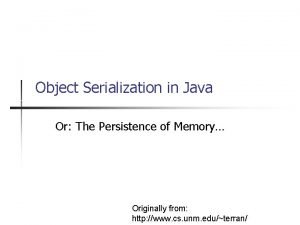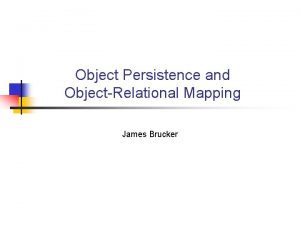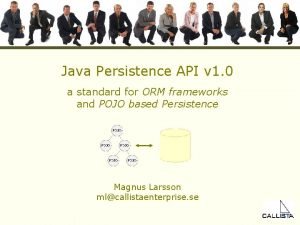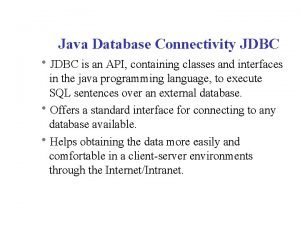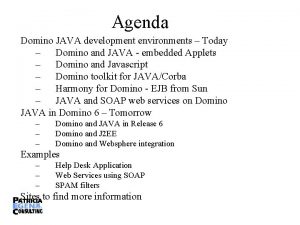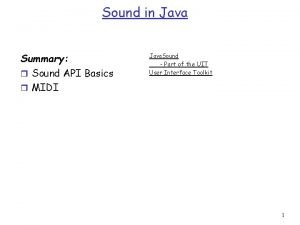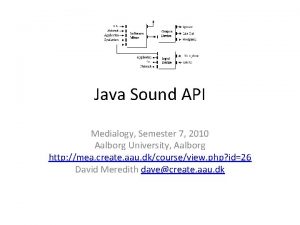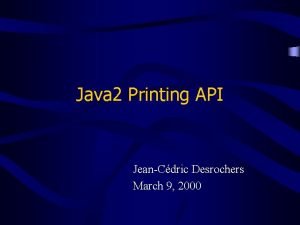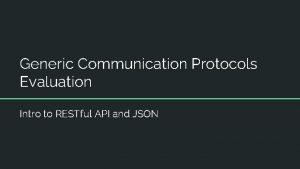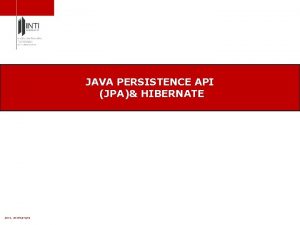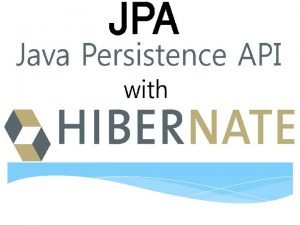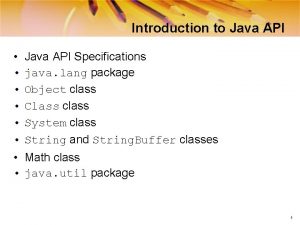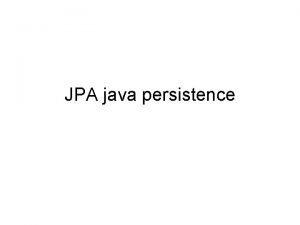Java Persistence API JPA Internet Course Hadassah Academic



















- Slides: 19

Java Persistence API (JPA) Internet Course Hadassah Academic College S. Karsenty

What is JPA? • a specification that defines the management of relational data in a Java application • There are several implementations available, most commonly Hibernate’s and Eclipse’s

@Entity • For each persisted entity, JPA creates a new table within the database • all chosen entities should define a primary key denoted by the @Id annotation. Together with the @Generated. Value annotation, we define that the primary key should be automatically generated when the record is persisted to the database. • When an object in Java is defined as an entity, all fields within it are automatically persisted as different columns within the entity table. • If there’s a field within a persisted object that we don’t want to persist to the database, we can declare the field transient with the @Transient annotation. @Entity public class Car { @Generated. Value @Id public long id; private String model; private Big. Decimal price; @Creation. Timestamp private Date created. At; @Update. Timestamp private Date updated. At; // getters and setters }

Relationships • Define DB relations with: @Entity • @One. To. One public class Steering. Wheel { • @One. To. Many @One. To. One private Car car • @Many. To. One // …. • @Many. To. Many } @Entity public class Car { @Generated. Value @Id public long id; // …. . }

Entity manager • the javax. persistence. Entity. Manager class specifies operations to and from the database • Create, Read, Update and Delete (commonly named CRUD) operations

Jpa. Repository • every repository in Spring Data extends the generic Repository interface • Jpa. Repository provides JPA related methods such as flushing the persistence context and delete records in a batch: • Crud. Repository provides CRUD functions • Paging. And. Sorting. Repository provides methods to do pagination and sort records • When we don’t need the full functionality provided by Jpa. Repository and Paging. And. Sorting. Repository, we can simply use the Crud. Repository

Crud operations • Given: @Entity public class Product { @Id private long id; private String name; // getters and setters } • All we need to implement a search operation in our DB is to define the interface as follow: @Repository public interface Product. Repository extends Jpa. Repository<Product, Long> { Product find. By. Name(String product. Name); } • The implementation will be automatically generated • How does it work? • Spring Data JPA has a built in query creation mechanism which can be used for parsing queries straight from the method name of a query method. • method names of your repository interface must combine the property names of an entity object and the supported keywords

crud. Repository interface • Contains all common operations: • save(…) – save an Iterable of entities. can pass multiple objects to save them in a batch • find. One(…) – get a single entity based on passed primary key value • find. All() – get an Iterable of all available entities in database • count() – return the count of total entities in a table • delete(…) – delete an entity based on the passed object • exists(…) – verify if an entity exists based on the passed primary key value

Building queries • In addition to standard queries, JPA allows you to build more complex ones • Instead of writing a query you build a method name • The name of your method is built according to a predefined syntax • Find, Find. By, Order. By, Desc, Asc, First<number> • Simply add the method names to your repository interface • Examples • • • for class Person with members lastname and firstname, you can build Person find. By. Lastname(String last); List<Person> find. By. Lastname. Order. By. Firstname. Asc(String lastname); long count. By. Lastname(String lastname); List<Person> find. First 10 By. Order. By. Lastname. Desc() • If you get an exception, it is likely that you got the syntax wrong

queries • you can also create your own queries @Query(value = "SELECT u FROM User u") List<User> find. All. Users(Sort sort); user. Repository. find. All(new Sort(Sort. Direction. ASC, "name")); @Query(value = "SELECT u FROM User u ORDER BY id") Page<User> find. All. Users. With. Pagination(Pageable pageable); @Query("SELECT u FROM User u WHERE u. status = : status and u. name = : name") User find. User. By. Status. And. Named. Params( @Param("status") Integer status, @Param("name") String name); @Query("SELECT p FROM USERS p WHERE LOWER(p. last. Name) = LOWER(: last. Name)") public List<User> find(@Param("last. Name") String last. Name); @Query(value = "SELECT * FROM USERS u WHERE u. status = 1") Collection<User> find. All. Active. Users();

Configuration • When creating the project here are common modules you can add:

Development • Intelli. J has a lot of support • For example with Devtools enabled, there’s a “Update” action which can trigger an application restart

Roadmap (1) • Define the database Bean with @Entity • Define fields • Define setters/ getters @Entity public class User { Spring input validation @Id @Generated. Value(strategy = Generation. Type. AUTO) private long id; @Not. Blank(message = "Name is mandatory") private String name; public User() {} public User(String name, String email) { this. name = name; } public void set. Id(long id) { this. id = id; } public long get. Id() { return id; } public void set. Name(String name) { this. name = name; } public String get. Name() { return name; } } More on validation here: https: //spring. io/guides/gs/validating-form-input/

Roadmap (2) • Define an Interface for JPA • Add the queries you need, for example “find. By. Name” import org. springframework. data. jpa. repository. Jpa. Repository; public interface User. Repository extends Jpa. Repository<User, Long> { List<User> find. By. Name(String name); }

Roadmap (3) • Let spring build the repository object for you • Inject the repository object • for example define a member in your class: public class Application { @Autowired public User. Repository user. Repository; …

Roadmap (4) • Configure your DB credentials in the file application. properties spring. datasource. url=jdbc: mysql: //localhost: 3306/spring? server. Timezone=UTC spring. datasource. username=root spring. datasource. password= spring. datasource. driver-class-name=com. mysql. jdbc. Driver spring. datasource. initialization-mode=always spring. jpa. hibernate. ddl-auto=create spring. jpa. database-platform=org. hibernate. dialect. My. SQL 57 Dialect spring. jpa. generate-ddl=true spring. jpa. show-sql=true

Roadmap (5) • Use in your controllers • inject any object you need in your controller: For example if you need the context, inject the context in your controller // the application context is injected via ctor private Application. Context context; @Autowired public User. Controller(Application. Context c) { this. context = c; } • Access the singleton repository bean from the context User. Repository repo = (User. Repository)this. context. get. Bean(User. Repository. class); • Run queries: User u = repo. find. By. Id(id); repo. delete(u); // etc…

Roadmap (6) • Bind the objects between the view and controller • Example: saving a User in the database @Post. Mapping("/adduser") public String add. User(@Valid User user, Binding. Result result, Model model) { // Spring validation according to User @Entity definition if (result. has. Errors()) { return "some-error-page"; } User. Repository repo = (User. Repository)this. context. get. Bean(User. Repository. class); repo. save(user); // select * from Users model. add. Attribute("users", repo. find. All()); // let the view display the list of users return ”show-users"; }

more • Full JPS/my. SQL example in course website • Need to add the module JPA in Intelli. J projects • Useful tutorials: • • https: //www. baeldung. com/the-persistence-layer-with-spring-and-jpa https: //www. baeldung. com/spring-data-jpa-query https: //www. baeldung. com/spring-data-repositories https: //www. baeldung. com/persistence-with-spring-series
 Hadassah moodle
Hadassah moodle Object persistence in java
Object persistence in java Object persistence in java
Object persistence in java Site:slidetodoc.com
Site:slidetodoc.com Dali java persistence tools
Dali java persistence tools Java persistence architecture
Java persistence architecture Java object persistence
Java object persistence Microsoft academic search api
Microsoft academic search api It academy microsoft
It academy microsoft Microsoft official academic course microsoft word 2016
Microsoft official academic course microsoft word 2016 Microsoft official academic course microsoft excel 2016
Microsoft official academic course microsoft excel 2016 Short authentic academic text
Short authentic academic text Microsoft official academic course microsoft word 2016
Microsoft official academic course microsoft word 2016 Java database connectivity api
Java database connectivity api Lotus notes java api
Lotus notes java api Java audio api
Java audio api Java sound api
Java sound api Java printer api
Java printer api Graphics api java
Graphics api java Generic communication model
Generic communication model

